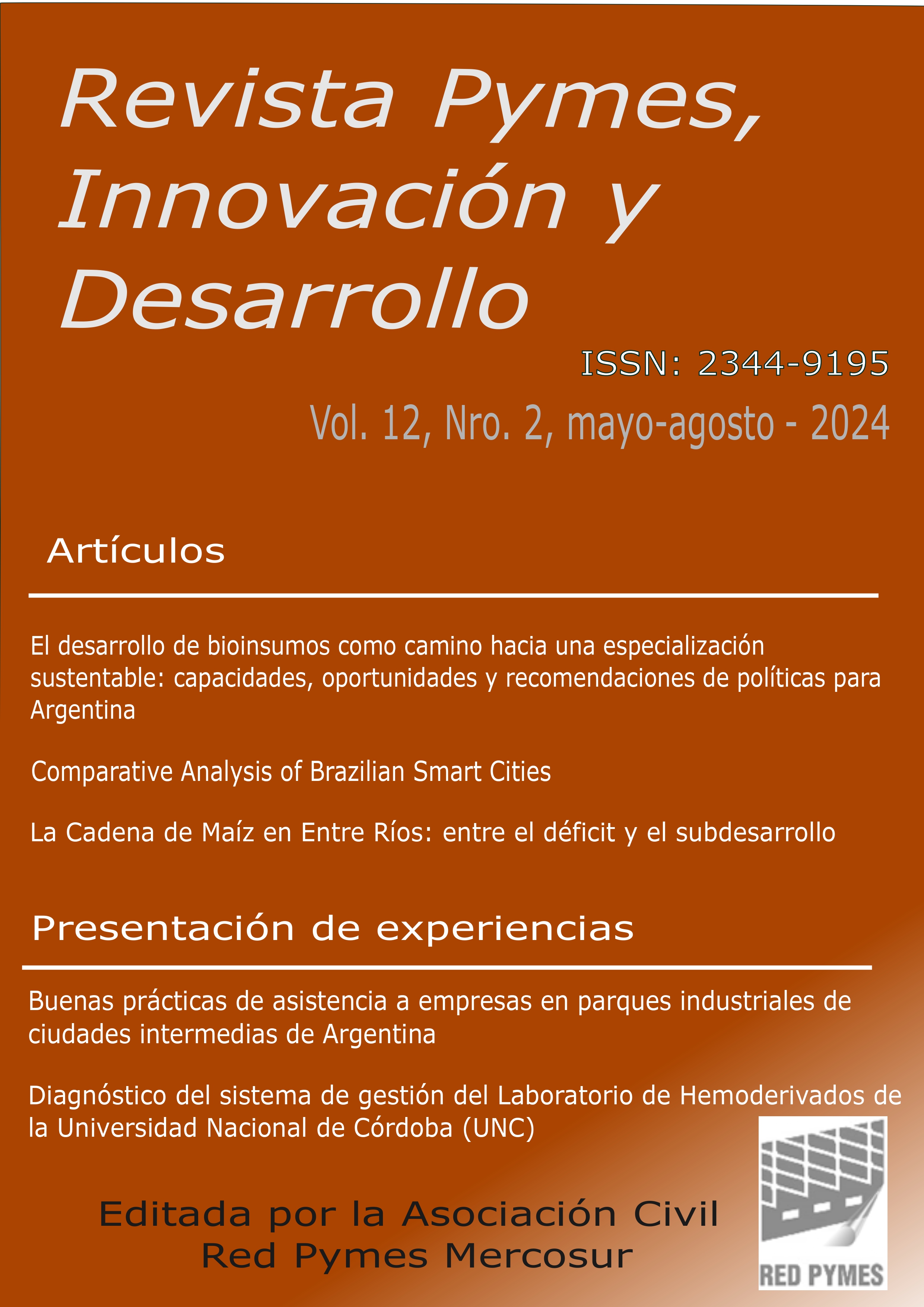La Cadena de Maíz en Entre Ríos: entre el déficit y el subdesarrollo
DOI:
https://doi.org/10.70453/2344.9195.v12.n2.46461Keywords:
Entre Ríos, corn, underdevelopment, chains, added valueAbstract
This article proposes a characterization of the corn chain in Entre Ríos as an underdeveloped chain, which is deduced from its comparison at national and international level and quantitatively estimates the degree of theoretical loss of added value that represents the high international insertion of the grain to the detriment of local industry demand, considering a time interval from 2019 to 2022 and using as a model for estimating domestic demand for corn, the scheme developed by the (at the time) Ministry of Agriculture, Livestock and Fisheries of the Argentine Nation in 2014. The analyzed data leads to the conclusion that the Province of Entre Ríos is not only behind internationally but also in comparison to the provinces within the Central Region concerning the development of the chain. Nevertheless, its agri-food tradition suggests the existence of development capacities that can be rapidly boosted with adequate public policies and coordination for adding value to corn at its source, especially in converting the grain into high-value protein. Furthermore, more intricate aspects like the medicinal use of corn alcohol and its derivatives should be studied in greater depth.
Downloads
References
Alburquerque, F. (2004). Desarrollo económico local y descentralización en América. Revista de la CEPAL, 157-171.
Bisang, R., Stubrin, L., & Anlló, G. (2011). Las empresas de biotecnología en Argentina. Santiago de Chile: CEPAL.
Byerlee, D., de Janvry, A., & Sadoulet, E. (2009). Agriculture for development: Toward a new paradigm. Annual Review of Resource Economics, 1(1), 15-31.
Castro, M., & Emiliozzi, A. (2020). El Bioetanol en base a maíz y su inserción en cadenas de valor en inserción en cadenas de valor en Argentina. Redes. Revista do Desenvolvimento Regional, 1302-1321.
CEPAL. (2022). Desagregación provincial del valor agregado bruto de la Argentina, base 2004, Documentos de Proyectos (LC/TS.2022/196; LC/BUE/TS.2022/9). CEPAL.
Ciani, R., & Aramayo, M. (2014). Cálculo de consumo de maíz en Argentina. Ministerio de Agricultura, Ganadería y Pesca. República Argentina.
Ciani, R., & Aramayo, M. (2017). Evolución del cálculo de consumo interno de maíz en Argentina. Buenos Aires: Subsecretaría de Mercados Agropecuarios (MAGyP).
Coronel, C. (2020). La Cadena Agroindustrial del Máiz en Argentina y el caso de Entre Ríos. Informe de Consultoría. Paraná: INTA Regional Paraná.
DGECER. (2023). Dirección General de Estadísticas y Censos. Provincia de Entre Ríos. Obtenido de https://www.entrerios.gov.ar/dgec/
Figliuolo, S., & Pujadas, M. (2013a). Cadena Maicera Santafesina. VIII Jornadas Interdisciplinarias de Estudios Agrarios y Agroindustriales. Facultad de Ciencias Económicas. UBA.
Figliuolo, S., & Pujadas, M. (2013b). La importancia del sector industrial en la cadena de maíz. Un análisis en la Provincia de Santa Fe. Decimoctavas Jornadas "Investigaciones en la Facultad" de Ciencias Económicas y Estadística. UNR.
Gereffi, G. (1999). International trade and industrial upgrading in the apparel commodity chain. Journal of International Economics, 48(1), 37-70.
Gereffi, G., Humphrey, J., & Sturgeon, T. (2005). The governance of global value chains. Review of International Political Economy, 12(1), 78-104.
Goizueta, M., Castellano, A., & Covacevich, M. (2013). Alternativas de agregado de valor en la cadena de maíz en Argentina. Estrategias y actores diferenciales por agroindustria derivada. XLIV Reunión Anual de la Asociación Argentina de Economía Agraria .
INDEC. (2023). Instituto Nacional de Estadísticas y Censos. República Argentina. Obtenido de https://www.indec.gob.ar/
Kaplinsky, R., & Morris, M. (2001). A handbook for value chain research. University of Sussex, Institute of Development Studies.
Lódola, A., Bisang, r., Bringo, R., & Morra, F. (2018). Cadenas de valor agroalimentarias. Evolución y cambios estructurales en el Siglo XXI. Ciudad Autónoma de Buenos Aires: DIRPOSE.
MAGyP. (2018-2022). Diversos informes y anuarios de coyuntura agroalimentaria. Ministerio de Agricultura, Ganadería y Pesca. República Argentina.
MAIZAR. (26 de agosto de 2017). Asociación de Maíz y Sorgo Argentino. Recuperado el septiembre de 2020, de http://www.maizar.org.ar/vertext.php?id=527
OEDE. (2023). Estadísticas e indicadores regionales de OEDE. Obtenido de https://www.argentina.gob.ar/trabajo/estadisticas/oede-estadisticas-provinciales
Paolilli, M., Cabrini, S., Fillat, F., & Pagliaricci, L. (2021). Evolución de la cadena de maíz en Argentina. EEA Pergamino, INTA.
Porter, M. (1985). Competitive advantage: Creating and sustaining superior performance. Free Press.
Reardon, T., Barrett, C., J, B., & Swinnen, J. (2009). Agrifood industry transformation and small farmers in developing countries. World development, 37(11), 1717-1727.
Saccucci, E., & Reinoso, P. (2023). Los biocombustibles y la transectorialidad del agronegocio en Córdoba, Argentina. Revista Ciencias Sociales, 55-72.
Storti, L. (2019). Informes de Cadenas de Valor. Cerales: Maíz - Febrero 2019. Secretaría de Política Económica, Ministerio de Hacienda. Argentina.
USDA. (2023). Economic Research Service - U.S. Ddepartmen of Agriculture. Obtenido de https://www.ers.usda.gov/
USDA ERS - Feed Grains Sector at a Glance. (Julio de 2024). USDA ERS - Feed Grains Sector at a Glance. Obtenido de https://www.ers.usda.gov/topics/crops/corn-and-other-feed-grains/feed-grains-sector-at-a-glance/#:~:text=Most%20of%20the%20crop%20is,and%20beverage%20and%20industrial%20alcohols.
Valentinuz, O., Eclesia, R., Melchiori, R., Vaccaro, M., Valentinuz, E., Gregorutti, V., Siede, M. (2024). Perspectivas de la producción y demanda de maíz en el sur entrerriano. Serie Extensión INTA Paraná, 25-33.
Downloads
Published
Issue
Section
License

This work is licensed under a Creative Commons Attribution 4.0 International License.
Authors who publish with this journal agree to the following terms:Authors retain copyright and grant the journal right of first publication with the work simultaneously licensed under a Creative Commons Attribution License that allows others to share the work with an acknowledgement of the work's authorship and initial publication in this journal.
Authors are able to enter into separate, additional contractual arrangements for the non-exclusive distribution of the journal's published version of the work (e.g., post it to an institutional repository or publish it in a book), with an acknowledgement of its initial publication in this journal.
Authors are permitted and encouraged to post their work online (e.g., in institutional repositories or on their website) prior to and during the submission process, as it can lead to productive exchanges, as well as earlier and greater citation of published work (See The Effect of Open Access).














